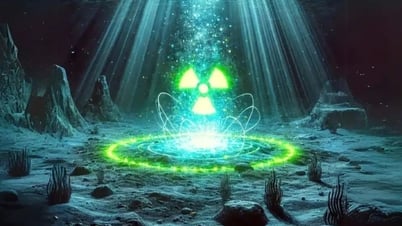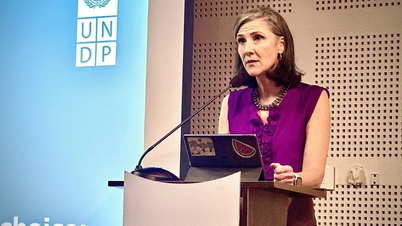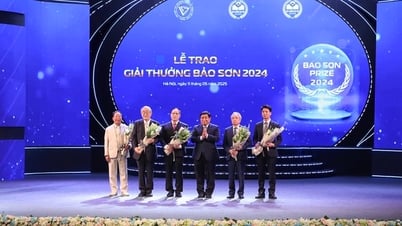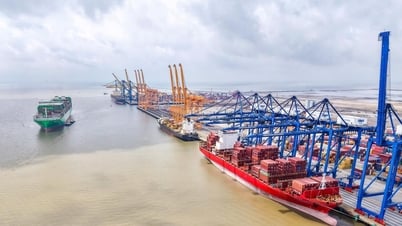With a magnetic field 280,000 times stronger than Earth's, the nearly 1,000-ton central magnet cluster of the ITER fusion reactor has just completed its structure, ready for the important installation step.
This is considered a major milestone in the journey to realizing the dream of a clean and nearly endless source of energy - similar to the way the sun shines.
Awaken the energy of the stars
For decades, fusion — the process of combining light nuclei like hydrogen to form helium, releasing energy — has been considered the "holy grail" of the energy industry.

ITER design image (Photo: ITER).
Unlike fission (the process of splitting heavy nuclei like uranium), fusion produces no long-term radioactive waste, is less risky, and has virtually unlimited fuel sources.
However, to induce a fusion reaction similar to that in the core of the sun, humans must create extreme conditions: temperatures of up to 150 million degrees Celsius - 10 times the temperature at the center of the sun - to force hydrogen atoms to fuse together despite the electrostatic repulsion between them.
That is why ITER (International Thermonuclear Experimental Reactor) - the world's largest thermonuclear reactor - was built in southern France with the cooperation of more than 30 countries, including: the US, Russia, China, Japan, India, South Korea and the entire EU.
"Holding the sun" with super magnets
To control the plasma at 150 million degrees Celsius - a substance hot enough to destroy any normal object - ITER uses tokamak technology, a doughnut-shaped design that creates a strong magnetic field to keep the plasma "suspended", away from the furnace walls.

ITER uses tokamak technology, a donut-shaped design that creates a strong magnetic field to keep the plasma "floating" (Photo: ITER).
The main character in this system is the Central Solenoid - a giant superconducting coil cluster weighing nearly 1,000 tons, which has just completed the main components and is ready for installation.
The Central Solenoid is capable of generating a magnetic field of 13 tesla, equivalent to 280,000 times the Earth's magnetic field. Even as a single component, it contains 6.4 gigajoules of magnetic energy - equivalent to the explosive force of 1,500kg of TNT.
What’s special is that while the plasma inside the tokamak needs to reach hundreds of millions of degrees Celsius, the Central Solenoid must be cooled to nearly -270⁰C, close to the temperature of liquid helium, to maintain its superconducting state. It is a huge technical challenge, when two opposite temperature states must coexist in a confined space and operate in sync.
An expensive but desirable dream
If on schedule, ITER will use about 50 megawatts of electricity to start the plasma, and recover 500 megawatts of heat from the fusion reaction — equivalent to a rate of energy generation 10 times greater than the input.
However, this is just raw heat energy. To produce electricity, this energy must be converted through a turbine system - and losses are inevitable.
Still, if ITER succeeds in maintaining a stable reaction, it will be the first industrial-scale demonstration that electrofusion is feasible, not just in theory but also on a scale that can be scaled up in the future.
It is no coincidence that the US, EU, China and Japan have all agreed to share technology, human resources and funding (estimated at tens of billions of dollars) for a common project. The Central Solenoid - manufactured and funded by the US - is proof of this.
Belief in global scientific cooperation
Mr. Pietro Barabaschi, Director General of ITER emphasized: "The uniqueness of ITER lies not only in its technological scale, but also in its international cooperation model, overcoming political and strategic differences to face a global challenge: the energy crisis and climate change".
As the world searches for alternative energy sources to fossil fuels, ITER holds out hope for a “carbon-free” future where fusion reactors can provide stable, safe energy without creating toxic waste.
But ITER is not without its share of skeptics. The project is nearly a decade behind schedule, over budget several times, and won’t produce its first plasma until 2033. And a commercial fusion power plant is still some time in the 2040s or 2050s.
Meanwhile, a series of private companies such as TAE Technologies (USA), Tokamak Energy (UK) and Helion Energy are pursuing more compact, more flexible models - with the promise of being able to bring fusion power to the grid many years sooner than ITER.
But it's important to remember that much of their progress is based on the science and data that ITER has already generated.
Source: https://dantri.com.vn/khoa-hoc/mat-troi-nhan-tao-nong-150-trieu-do-c-khai-mo-nguon-nang-luong-vo-tan-20250509092824986.htm


![[Photo] Prime Minister Pham Minh Chinh receives Swedish Minister of International Development Cooperation and Foreign Trade](https://vphoto.vietnam.vn/thumb/1200x675/vietnam/resource/IMAGE/2025/5/12/ae50d0bb57584fd1bbe1cd77d9ad6d97)

![[Photo] Prime Minister Pham Minh Chinh works with the Standing Committee of Thai Binh Provincial Party Committee](https://vphoto.vietnam.vn/thumb/1200x675/vietnam/resource/IMAGE/2025/5/12/f514ab990c544e05a446f77bba59c7d1)



























































































Comment (0)